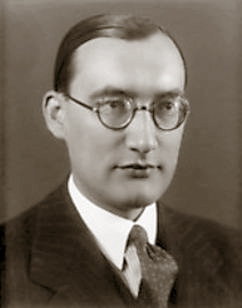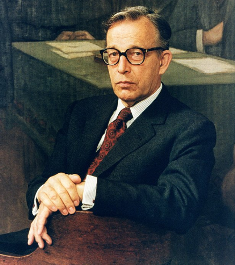
Stasys Lozoraitis was a prominent Lithuanian diplomat and politician who served as the Foreign Minister of Lithuania from 1934 until 1938. After Lithuania lost its independence in June 1940, Lozoraitis headed the Lithuanian diplomatic service from 1940 to his death in 1983. Most western countries did not recognize the Soviet occupation and continued to recognize legations and envoys of independent Lithuania thus maintaining the legal continuity of Lithuania.

The Latvian diplomatic service in exile was the only governmental body of the Republic of Latvia which continued its activities during the Nazi and Soviet occupation of Latvia during 1940–1991. Latvian diplomats who were stationed in embassies and consulates at the moment of the occupation in 1940, refused to recognize the occupation and return to Soviet Latvia. They continued to formally represent the interests of Latvia in countries that did not recognize the Soviet annexation. After the restoration of Latvian independence in 1991, the diplomats started reporting to the restored Latvian Ministry of Foreign Affairs.

Stasys LozoraitisJr. was a Lithuanian diplomat and politician who served as the Head of the Lithuanian Diplomatic Service from 1987 to 1991, Chief Diplomat to the United States 1991 to 1993 and Ambassador to Italy 1993 to 1994. He was a son of the famous diplomat Stasys Lozoraitis (1898–1983) and brother of Kazys Lozoraitis.

The three Baltic countries, or the Baltic states – Estonia, Latvia, and Lithuania – are held to have continued as legal entities under international law while under the Soviet occupation from 1940 to 1991, as well as during the German occupation in 1941–1944/1945. The prevailing opinion accepts the Baltic thesis of illegal occupation and the actions of the USSR are regarded as contrary to international law in general and to the bilateral treaties between the USSR and the three Baltic countries in particular.

Kazys Lozoraitis was a prominent Lithuanian diplomat and cultural activist. He was the first ambassador of Lithuania to the Holy See and to the Sovereign Military Order of Malta.

The Supreme Committee for the Liberation of Lithuania or VLIK was an organization seeking independence of Lithuania. It was established on November 25, 1943, during the Nazi occupation. After World War II it moved abroad and continued its operations in Germany and the United States. VLIK claimed to be the legal representative of the Lithuanian parliament and government, but did not enjoy international recognition. It was dissolved in 1990 when Lithuania re-established its independence.

The Soviet Union issued an ultimatum to Lithuania before midnight of June 14, 1940. The Soviets, using a formal pretext, demanded that an unspecified number of Soviet soldiers be allowed to enter the Lithuanian territory and that a new pro-Soviet government be formed. The ultimatum and subsequent incorporation of Lithuania into the Soviet Union stemmed from the division of Eastern Europe into the German and Soviet spheres of influence agreed in the Molotov–Ribbentrop Pact of August 1939. Lithuania, along with Latvia and Estonia, fell into the Soviet sphere. According to the Soviet–Lithuanian Mutual Assistance Treaty of October 1939, Lithuania agreed to allow some 20,000 Soviets troops to be stationed at bases within Lithuania in exchange for receiving a portion of the Vilnius Region. Further Soviet actions to establish its dominance in its sphere of influence were delayed by the Winter War with Finland and resumed in spring 1940 when Germany was making rapid advances in western Europe. Despite the threat to the country's independence, Lithuanian authorities did little to plan for contingencies and were unprepared for the ultimatum.
Presidential elections were held in Lithuania on 14 February 1993. They were the first presidential elections under the new October 1992 constitution and the first direct presidential elections in the country's history.

The Baltic Legations were the missions of the exiled Baltic diplomatic services from 1940 to 1991. After the Soviet occupation of the Baltic states in 1940, the Baltic states instructed their diplomats to maintain their countries' legations in several Western capitals. Members of the Estonian diplomatic service, the Latvian diplomatic service and the Lithuanian diplomatic service continued to be recognised as the diplomatic representatives of the independent pre-World War II states of Estonia, Latvia and Lithuania, whose annexation by the Soviet Union was not recognised by the United States, the United Kingdom, or France. The legations provided consular services to exiled citizens of the Baltic states from 1940 to 1991.

Embassy of Lithuania in Washington, D.C., is the diplomatic mission of the Republic of Lithuania to the United States. It is located at 2622 16th Street Northwest, Washington, D.C., in the Adams Morgan neighborhood.
The Diplomatic Service of the Republic of Lithuania is the part of the governmental service tasked with enforcing the foreign policy set by the President, the Parliament, and the Government of the Republic of Lithuania. The head of the service is the Foreign Minister.
Stasys Antanas Bačkis was a Lithuanian diplomat and civil servant who served as an assistant in the Lithuanian Ministry of Foreign Affairs from 1930 until 1938, Head of the Lithuanian Embassy in Paris and later Head of the Lithuanian Diplomatic Service in Washington D.C. from 1983 until 1987.
Edvardas Turauskas was a Lithuanian diplomat.
The Pontifical College of St. Casimir is a priestly seminary in Rome, Italy. Named after Saint Casimir, the patron saint of Lithuania, it was established on 19 October 1945 to educate priests who had fled Soviet-occupied Lithuania.

Lithuania–Mexico relations are the bilateral relations between Lithuania and Mexico. Both nations are members of the Organisation for Economic Co-operation and Development. Neither country has a resident ambassador.

Bronius Kazys Balutis (1880–1967) was a Lithuanian diplomat. He worked at the Ministry of Foreign Affairs of Lithuania in 1919–1928 and was involved in many of the major international negotiations of the period. He was the Lithuanian envoy to United States (1928–1934) and to the United Kingdom (1934–1967).
Vincas Balickas was a Lithuanian diplomat. He was the Lithuanian representative to the United Kingdom from 1967 to 1993. Posted to London in 1938, he continued to represent interwar Lithuania despite the Soviet occupation in 1940 thus preserving the state continuity of Lithuania.










